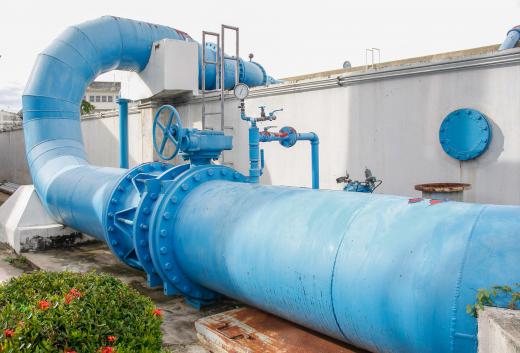Sludge bulking is a problem that can occur in a method of sewage treatment known as the activated sludge process. This treatment involves introducing a combination of air and microorganisms — such as aerobic bacteria and protozoa — to sewage and industrial organic waste to encourage growth and multiplication. The microorganisms congregate around the suspended organic material on which they feed, causing it to settle out of suspension and leaving relatively clean effluent to proceed to further treatment. Sludge bulking is a problem that occurs due to the excessive growth of some types of bacteria and hinders the settling process, rendering the water cloudy and leading to the release of effluent that does not meet environmental standards.
The activated sludge process works by flocculation — the clumping together of suspended particles to form larger masses that settle out of the water. Typically, wastewater containing large amounts of small, suspended particles of organic matter enters a tank where suitable microorganisms are introduced, along with sufficient air to promote growth and multiplication of the right kinds of bacteria and protozoa, allowing flocculation to take place. The microorganisms tend to stick to the organic material and to each other, creating relatively large particles known as flocs. Water is continually or periodically drawn off into a clarifier tank, where the flocs settle to the bottom. Some of the settled material, still rich in the microorganisms required for flocculation, is then reintroduced into the flocculation tank to allow the process to continue.

Three main types of sludge bulking can affect the settling process. Bulking caused by filamentous bacteria is the commonest form. These bacteria normally aid the flocculation process, as the filaments they produce help to trap suspended particles and generate larger, more stable, flocs. Excessive amounts of filamentous bacteria, however, lead to bulking as the filaments may extend out of small floc particles and keep them separated from one another, preventing the formation of larger particles that will settle easily. There are thought to be about 25 different types of filamentous bacteria in activated sludge, all of which can cause problems.
Polysaccharide bulking, also known as “slime bulking,” happens when activated sludge bacteria produce too much polysaccharide. This may occur when the mix is low in nutrients or oxygen, or when the food to microorganism (F/M) ratio is too high. Polysaccharides — complex sugars that include starch — are produced outside the bacterial cells and enable flocculation by helping the bacteria to stick together. If too much is produced, however, it can prevent settling of material.
Zoogleal bulking is caused by an overabundance of the bacterium Zoogloea ramigera, a floc-forming microorganism with a dendritic, or tree-like, growth pattern. This can happen when the F/M ratio is too high or in low oxygen conditions. The bacterium is one of the main contributors to floc formation under normal conditions, but an overabundance of this species can impede the process and lead to a similar kind of bulking to that caused by filamentous bacteria.
A number of methods are used to treat or prevent sludge bulking. Samples of sewage can be examined microscopically at regular intervals to monitor the abundance of microorganisms that can cause problems. Where a potential problem is identified, action can be taken in advance — for example, careful adjustment of the rate of return of activated sludge to the flocculation tank. If bulking is already taking place, it can be treated by adding coagulants or certain polymers to the water to encourage flocculation and settling. Another approach is chlorination at a level that inhibits bacterial filaments outside the flocs, but does not penetrate into the flocs, leaving the beneficial internal microorganisms unharmed.
